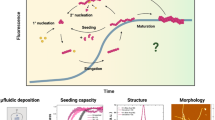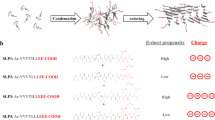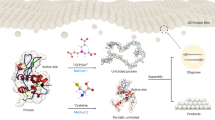Abstract
In nature, sophisticated functional materials are created through hierarchical self-assembly of simple nanoscale motifs1,2,3,4. In the laboratory, much progress has been made in the controlled assembly of molecules into one-5,6,7, two-6,8,9 and three-dimensional10 artificial nanostructures, but bridging from the nanoscale to the macroscale to create useful macroscopic materials remains a challenge. Here we show a scalable self-assembly approach to making free-standing films from amyloid protein fibrils. The films were well ordered and highly rigid, with a Young's modulus of up to 5–7 GPa, which is comparable to the highest values for proteinaceous materials found in nature. We show that the self-organizing protein scaffolds can align otherwise unstructured components (such as fluorophores) within the macroscopic films. Multiscale self-assembly that relies on highly specific biomolecular interactions is an attractive path for realizing new multifunctional materials built from the bottom up.
This is a preview of subscription content, access via your institution
Access options
Subscribe to this journal
Receive 12 print issues and online access
$259.00 per year
only $21.58 per issue
Buy this article
- Purchase on Springer Link
- Instant access to full article PDF
Prices may be subject to local taxes which are calculated during checkout




Similar content being viewed by others
References
Dobson, C. M. Protein folding and misfolding. Nature 426, 884–890 (2003).
Buehler, M. J. & Ackbarow, T. Nanomechanical strength mechanisms of hierarchical biological materials and tissues. Comput. Methods Biomech. Biomed. Eng. 11, 595–607 (2008).
Buehler, M. J. & Yung, Y. C. Deformation and failure of protein materials in physiologically extreme conditions and disease. Nature Mater. 8, 175–188 (2009).
Whitesides, G. M. & Grzybowski, B. Self-assembly at all scales. Science 295, 2418–2421 (2002).
Kol, N. et al. Self-assembled peptide nanotubes are uniquely rigid bioinspired supramolecular structures. Nano Lett. 5, 1343–1346 (2005).
Zhang, S. Fabrication of novel biomaterials through molecular self-assembly. Nature Biotechnol. 21, 1171–1178 (2003).
Mao, C. et al. Virus-based toolkit for the directed synthesis of magnetic and semiconducting nanowires. Science 303, 213–217 (2004).
Rothemund, P. W. K. Folding DNA to create nanoscale shapes and patterns. Nature 440, 297–302 (2006).
Zhang, S., Holmes, T., Lockshin, C. & Rich, A. Spontaneous assembly of a self-complementary oligopeptide to form a stable macroscopic membrane. Proc. Natl Acad. Sci. USA 90, 3334–3338 (1993).
Goodman, R. P. et al. Rapid chiral assembly of rigid DNA building blocks for molecular nanofabrication. Science 310, 1661–1665 (2005).
Chiti, F. & Dobson, C. M. Protein misfolding, functional amyloid, and human disease. Annu. Rev. Biochem. 75, 333–366 (2006).
Kelly, J.W. Towards an understanding of amyloidogenesis. Nature Struct. Biol. 9, 323–325 (2002).
Dobson, C. M. Protein misfolding, evolution and disease. Trends Biochem. Sci. 24, 329–332 (1999).
Fändrich, M., Fletcher, M. A. & Dobson, C. M. Amyloid fibrils from myoglobin. Nature 410, 165–166 (2001).
Fowler, D. M., Koulov, A. V., Balch, W. E. & Kelly, J. W. Functional amyloid—from bacteria to humans. Trends Biochem. Sci. 32, 217–224 (2007).
Chapman, M. R. et al. Role of Escherichia coli curli operons in directing amyloid fiber formation. Science 295, 851–855 (2002).
Maji, S. K. et al. Functional amyloids as natural storage of peptide hormones in pituitary secretory granules. Science 325, 328–332 (2009).
Huang, Y., Duan, X., Wei, Q. & Lieber, C. M. Directed assembly of one-dimensional nanostructures into functional networks. Science 291, 630–633 (2001).
Ikkala, O. & ten Brinke, G. Functional materials based on self-assembly of polymeric supramolecules. Science 295, 2407–2409 (2002).
Knowles, T. P. et al. Role of intermolecular forces in defining material properties of protein nanofibrils. Science 318, 1900–1903 (2007).
Reches, M. & Gazit, E. Controlled patterning of aligned self-assembled peptide nanotubes. Nature Nanotech. 1, 195–200 (2006).
Gennadios, A. (ed.) Protein Based Films and Coatings (CRC Press, 2002).
Sawaya, M. R. et al. Atomic structures of amyloid cross-beta spines reveal varied steric zippers. Nature 447, 453–457 (2007).
Jaroniec, C. P. et al. High resolution molecular structure of a peptide in an amyloid fibril determined by magic angle spinning NMR spectroscopy. Proc. Natl Acad. Sci. USA 101, 711–716 (2004).
Donald, A. M., Windle, A. H. & Hanna, S. Liquid Crystalline Polymers 2nd edn (Cambridge Univ. Press, 2006).
Corrigan, A. M., Müller, C. & Krebs, M. R. H. The formation of nematic liquid crystal phases by hen lysozyme amyloid fibrils. J. Am. Chem. Soc. 129, 14740–14741 (2006).
Smith, J. F., Knowles, T. P. J., Dobson, C. M., Macphee, C. E. & Welland, M. E. Characterization of the nanoscale properties of individual amyloid fibrils. Proc. Natl Acad. Sci. USA 103, 15806–15811 (2006).
Baughman, R. H., Zakhidov, A. A. & de Heer, W. A. Carbon nanotubes—the route toward applications. Science 297, 787–792 (2002).
Krebs, M. R. H., Bromley, E. H. C. & Donald, A. M. The binding of thioflavin-T to amyloid fibrils: localisation and implications. J. Struct. Biol. 149, 30–37 (2005).
Kosevich, A. M., Lifshitz, E. M., Landau, L. D. & Pitaevskii, L. P. Theory of Elasticity (Butterworth-Heinemann, 1986).
Acknowledgements
The authors acknowledge support from Nokia Research Cambridge, the UK Engineering and Physical Sciences Research Council (EPSRC), the Interdisciplinary Research Council (IRC) in Nanotechnology, St John's College, Cambridge, and the Wellcome Trust. We thank C. Dobson, E. Eiser, M. Haddow and C. Meier for valuable discussions, and A. Rayment and I. Ganney for assistance with the mechanical measurements.
Author information
Authors and Affiliations
Contributions
T.P.J.K., T.W.O., A.K.B. and D.Y.C. performed the experiments. T.P.J.K., T.W.O., D.Y.C. and M.E.W. analysed the data. T.P.J.K., A.K.B. and M.E.W. co-wrote the paper. All authors discussed the results and commented on the manuscript.
Corresponding author
Ethics declarations
Competing interests
The authors declare no competing financial interests.
Supplementary information
Supplementary information
Supplementary information (PDF 325 kb)
Rights and permissions
About this article
Cite this article
Knowles, T., Oppenheim, T., Buell, A. et al. Nanostructured films from hierarchical self-assembly of amyloidogenic proteins. Nature Nanotech 5, 204–207 (2010). https://doi.org/10.1038/nnano.2010.26
Received:
Accepted:
Published:
Issue Date:
DOI: https://doi.org/10.1038/nnano.2010.26
This article is cited by
-
Protein nanowires with tunable functionality and programmable self-assembly using sequence-controlled synthesis
Nature Communications (2022)
-
Controlled self-assembly of plant proteins into high-performance multifunctional nanostructured films
Nature Communications (2021)
-
Instantaneous fibrillation of egg white proteome with ionic liquid and macromolecular crowding
Communications Materials (2020)
-
Hierarchically oriented organization in supramolecular peptide crystals
Nature Reviews Chemistry (2019)
-
Mechanically rigid supramolecular assemblies formed from an Fmoc-guanine conjugated peptide nucleic acid
Nature Communications (2019)



